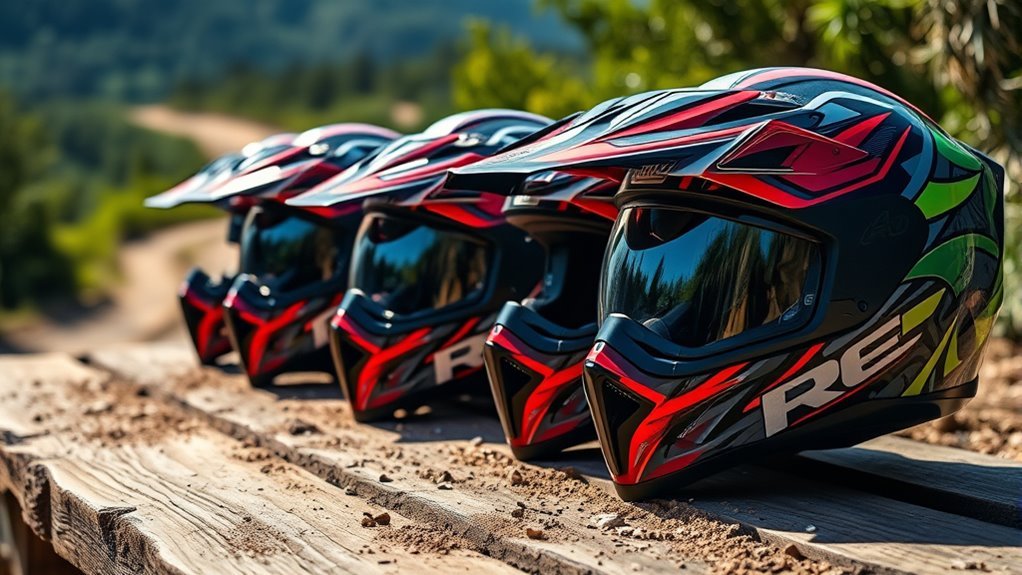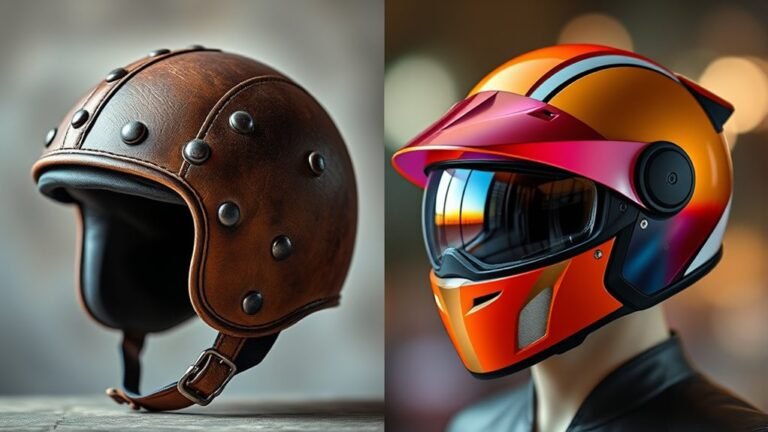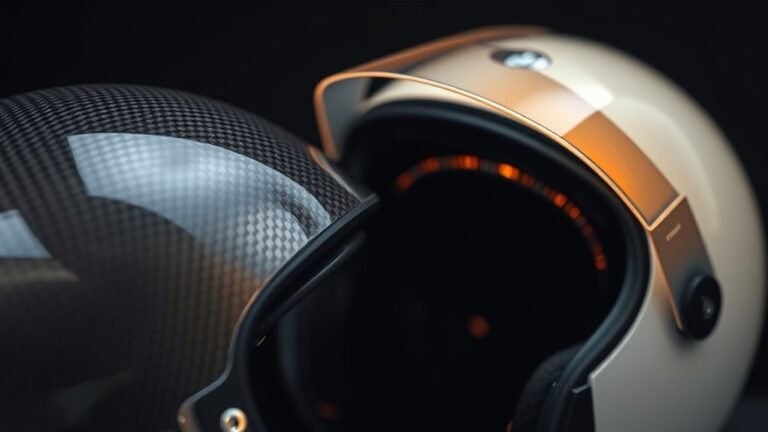Best Off-Road Motorcycle Helmets
When choosing the best off-road motorcycle helmet, focus on features like lightweight materials, advanced safety ratings such as DOT or Snell certifications, and effective ventilation systems. Opt for helmets compatible with goggles for improved visibility. Check fit and sizing options to guarantee comfort and safety. Popular brands like Arai, Bell, and Fox Racing offer reliable choices across various price ranges. For peak performance, consider maintenance tips that can prolong the helmet’s lifespan. There’s more to explore on choosing the right helmet.
Key Features to Look for in Off-Road Helmets
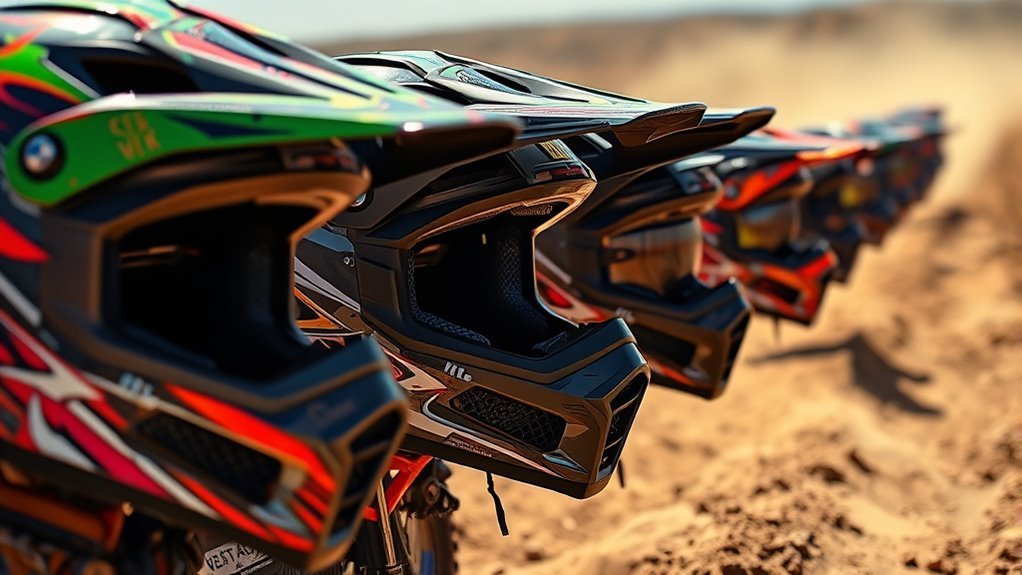
When choosing an off-road helmet, there are several key features you should consider to guarantee both safety and comfort. First, look for advanced off-road technology, such as impact-resistant materials and proper ventilation systems that keep you cool during intense rides. A lightweight design is vital, as it reduces fatigue on long journeys. Additionally, helmet customization options, like removable liners and adjustable visors, allow you to tailor the fit and functionality to your riding style. Consider the helmet’s shape and size, confirming it fits snugly without compromising comfort. Finally, check for compatibility with goggles to enhance visibility. Prioritizing these features guarantees you’re ready to tackle any terrain while enjoying the freedom of the ride.
Top Safety Ratings and Certifications
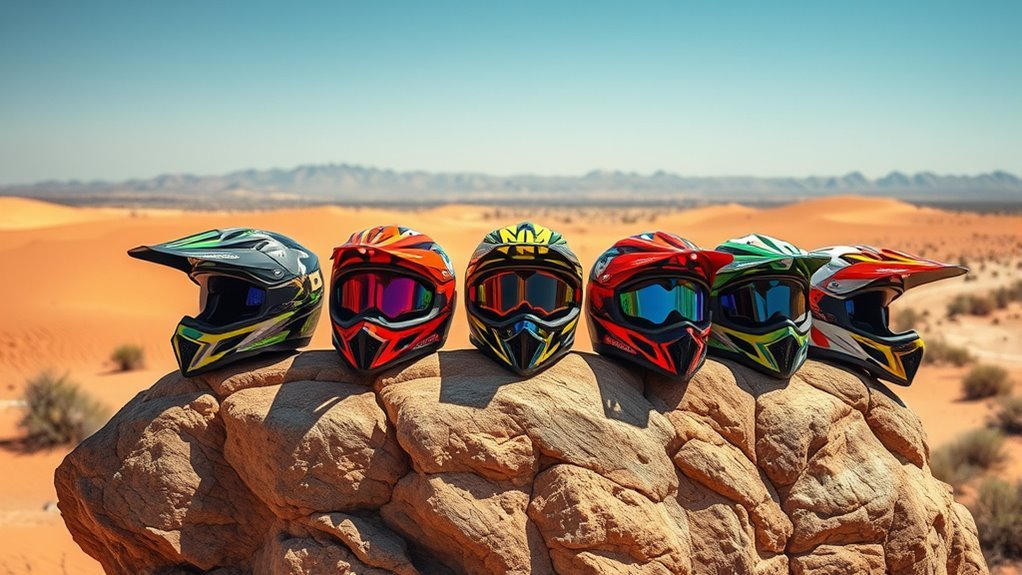
Choosing the right off-road helmet goes beyond just comfort and features; safety ratings and certifications play a vital role in ensuring your protection on the trails. When selecting a helmet, you should look for those that meet rigorous safety standards established by reputable certification agencies like DOT, Snell, or ECE. These agencies assess helmets for impact resistance, penetration, and retention system effectiveness, ensuring they provide adequate protection during a fall. Helmets with high safety ratings not only reduce the risk of serious injury but also offer peace of mind as you navigate challenging terrains. Remember, it’s not just about style or price; investing in a helmet with solid certifications is essential for your freedom and safety while riding off-road.
Lightweight Materials for Enhanced Comfort
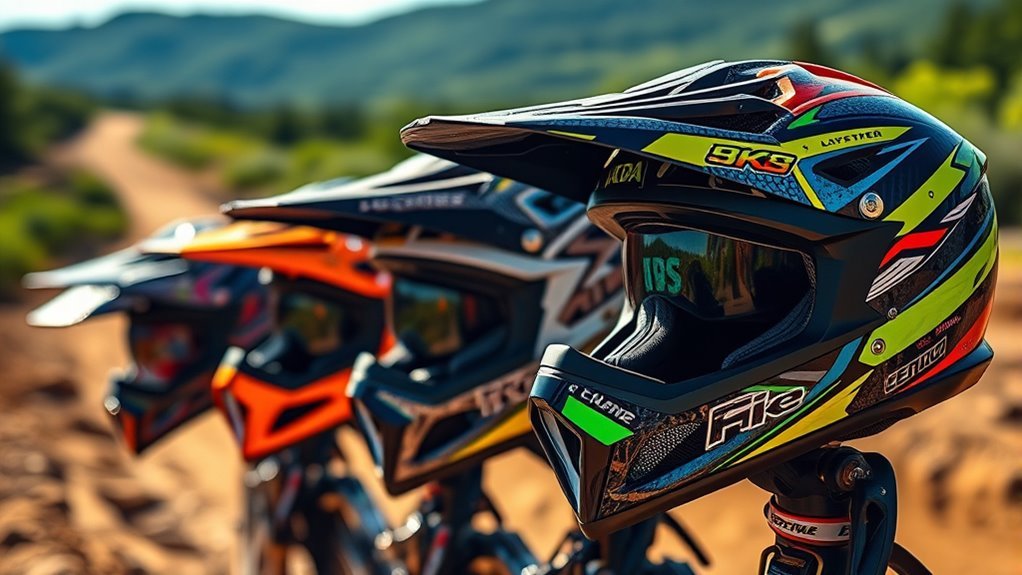
When you’re choosing an off-road motorcycle helmet, the materials used can greatly impact both comfort and performance. Advanced composite materials not only reduce weight but also enhance ventilation and breathability, keeping you cooler during long rides. Understanding the latest weight reduction techniques can help you select a helmet that offers superior comfort without compromising safety.
Advanced Composite Materials
In the domain of off-road motorcycle helmets, advanced composite materials play an essential role in enhancing rider comfort and safety. These materials, such as carbon fiber, are engineered to provide superior impact resistance while remaining lightweight. This balance allows you to ride longer without fatigue, focusing on the thrill of the adventure ahead.
- Carbon Fiber: Offers exceptional strength-to-weight ratio.
- Kevlar: Enhances durability without adding bulk.
- Polycarbonate: Provides solid impact resistance at a lower cost.
- Fiberglass: Offers a good mix of weight and protection.
- Expanded Polystyrene (EPS): Absorbs energy during impacts, enhancing safety.
With these advanced composites, you can enjoy the freedom of off-road riding while knowing you’re protected.
Ventilation and Breathability
Although safety is paramount, ventilation and breathability are equally critical for off-road motorcycle helmets, especially during long rides in challenging conditions. Proper airflow channels and breathable linings guarantee you stay cool and comfortable, allowing you to focus on the ride. A well-ventilated helmet helps minimize sweat buildup, enhancing your overall experience on the trails.
| Feature | Importance |
|---|---|
| Breathable Linings | Promotes moisture wicking |
| Airflow Channels | Enhances cooling efficiency |
| Ventilation Ports | Directs airflow effectively |
| Moisture Barriers | Keeps sweat away from face |
| Adjustable Vents | Customizes airflow as needed |
Choosing a helmet with these features can make all the difference, assuring you enjoy every moment of your adventure.
Weight Reduction Techniques
Choosing a lightweight helmet can greatly enhance your comfort during off-road rides, as the right materials reduce fatigue and improve overall performance. By focusing on weight distribution and material enhancement, manufacturers create helmets that won’t weigh you down.
Consider the following lightweight materials that notably contribute to comfort:
- Carbon fiber: Exceptional strength-to-weight ratio
- Kevlar: Durable and lightweight for added protection
- Expanded polystyrene (EPS): Effective energy absorption
- Polycarbonate: Impact-resistant and lighter than fiberglass
- Advanced composites: Combine multiple materials for peak performance
Investing in a helmet made from these materials not only boosts your riding experience but also allows for longer, more exhilarating adventures without the burden of unnecessary weight.
Ventilation Systems for Optimal Airflow
Effective ventilation systems are essential for any off-road motorcycle helmet, as they play an important role in maintaining comfort and safety during rides. When you’re tackling rugged terrains, a well-designed airflow optimization can make all the difference. Here’s a quick comparison of different ventilation technologies:
| Type of Ventilation | Benefits |
|---|---|
| Open-Cell Foam | Great breathability |
| Adjustable Vents | Customizable airflow |
| Mesh Liners | Lightweight & airy |
These ventilation technologies guarantee that heat and moisture escape, allowing for a cooler ride. When you choose a helmet with an effective system, you enhance your overall experience. Prioritize airflow optimization to enjoy your adventures without discomfort or distraction.
Visor Styles and Visibility Enhancements
When traversing challenging terrains, the right visor style can markedly enhance your visibility and overall riding experience. Understanding visor functionality and integrating advanced visibility technology is essential for off-road enthusiasts. Here are key features to take into account:
- Anti-fog coatings: Prevents fogging during variable weather.
- Tinted visors: Reduces glare from the sun, improving clarity.
- Wide field of view: Expands peripheral vision for better awareness.
- Quick-release systems: Allows for easy adjustments on the go.
- Integrated sun visors: Provides additional UV protection without sacrificing visibility.
Choosing a helmet with these features guarantees you’ll navigate rough terrains confidently, enjoying the freedom of the ride while staying safe and aware.
Noise Reduction and Acoustic Performance
When choosing an off-road motorcycle helmet, consider how soundproofing materials and overall design impact noise levels during your ride. Quality ventilation systems can also play a significant role in balancing comfort and acoustic performance. Understanding these factors will help you select a helmet that minimizes distractions from wind and engine noise, enhancing your overall experience.
Soundproofing Materials Quality
While you might prioritize safety features in off-road motorcycle helmets, the quality of soundproofing materials is equally important for a comfortable ride. The right soundproofing can enhance your experience by reducing wind noise and allowing you to focus on the thrill of the adventure.
Consider these factors when evaluating soundproofing materials:
- Soundproofing effectiveness: Look for helmets that minimize external noise considerably.
- Material durability: Confirm that the soundproofing materials can withstand harsh conditions.
- Weight: Lightweight materials can enhance comfort without sacrificing soundproofing.
- Fit and seal: A proper fit helps maintain soundproofing integrity.
- Maintenance: Easy-to-clean materials confirm longevity and effectiveness.
Selecting a helmet with high-quality soundproofing materials will elevate your off-road experience, providing the freedom you crave.
Ventilation and Noise Levels
Although you may focus on safety and soundproofing in off-road motorcycle helmets, ventilation plays an essential role in enhancing your riding experience. Effective ventilation types, such as top vents and chin guards, help regulate temperature, ensuring you stay comfortable during long rides. A well-ventilated helmet reduces heat buildup and moisture, preventing fatigue and distraction. However, achieving the right balance between ventilation and noise insulation is vital. While more vents can increase airflow, they might also allow unwanted noise to enter, impacting your concentration. Look for helmets that optimize both aspects, offering robust noise reduction while still providing adequate airflow. Ultimately, a helmet that harmonizes ventilation and noise levels empowers you to ride freely and confidently.
Helmet Design Impact
The design of a helmet greatly influences its noise reduction and acoustic performance, impacting your overall riding experience. Effective helmet ergonomics and appealing design aesthetics work hand-in-hand to provide not just comfort but also essential noise management. A well-designed helmet can help you stay focused on the trail, minimizing distractions from wind and engine noise.
- Streamlined shapes reduce drag and turbulence.
- Padding materials absorb sound effectively.
- Vent placements can enhance or detract from noise levels.
- Lightweight construction guarantees comfort over long rides.
- Adjustable visors can aid in sound direction.
Choosing a helmet that balances these elements will enhance your freedom, allowing you to fully immerse yourself in the thrill of off-road riding.
Fit and Sizing Options
Finding the right fit for your off-road motorcycle helmet is vital for both comfort and safety. A helmet that’s too loose can shift during your ride, compromising protection, while a tight fit can cause discomfort and distraction. To guarantee you get the best fit, start by consulting sizing charts provided by manufacturers. These charts typically include head circumference measurements, which help you determine your size accurately. Many helmets also offer fit adjustments, such as removable liners or adjustable straps, allowing you to customize the fit further. Remember that trying on different models is important; each brand can have unique shapes and sizes. Ultimately, a well-fitted helmet enhances your freedom on the trails, letting you focus solely on the adventure ahead.
Popular Brands and Their Offerings
Numerous brands dominate the off-road motorcycle helmet market, each offering distinct features tailored to different riding styles and preferences. When you explore brand comparisons, you’ll discover innovations that enhance safety and performance. Here are some top contenders:
Explore the top brands in off-road motorcycle helmets, each designed for safety, comfort, and performance tailored to your riding style.
- Arai: Known for superior fit and comfort, with advanced ventilation systems.
- Fox Racing: Offers a blend of style and function, often featuring bold designs.
- Bell: Renowned for their lightweight helmets with excellent impact protection.
- Shoei: Focuses on aerodynamics and noise reduction, perfect for long rides.
- HJC: Provides affordable options without compromising on quality or safety.
These brands continuously push the envelope with product innovations, ensuring you find the right helmet for your off-road adventures.
Price Range and Budget Considerations
When considering off-road motorcycle helmets, it’s essential to balance quality and budget, as prices can vary considerably based on features and brand reputation. You’ll find budget options that provide decent protection without breaking the bank, typically ranging from $100 to $300. However, investing in higher-end helmets, priced between $300 and $600, often means enhanced safety features, better ventilation, and improved comfort. Conducting a price comparison among different brands can reveal significant differences in value, helping you make an informed choice. Remember, while it’s tempting to go for the cheapest option, prioritizing safety and durability is key to ensuring you enjoy the freedom of the ride without unnecessary risk. Choose wisely, and you’ll find the right balance for your needs.
Maintenance Tips for Longevity
To guarantee your off-road motorcycle helmet lasts as long as possible, regular maintenance is essential. By implementing effective cleaning techniques and proper storage solutions, you can greatly extend its lifespan. Here are some practical tips to keep in mind:
- Clean the interior padding with mild soap and warm water, avoiding harsh chemicals.
- Use a soft cloth to wipe the exterior, removing dirt and debris after each ride.
- Store your helmet in a cool, dry place, away from direct sunlight.
- Regularly check for any cracks or wear, addressing issues immediately.
- Replace the foam padding as needed for comfort and safety.
Following these maintenance tips not only protects your investment but guarantees your adventures remain safe and enjoyable.
Frequently Asked Questions
Can I Use an Off-Road Helmet for Street Riding?
Sure, you can use an off-road helmet for street riding, but it’s like using a superhero cape for a casual stroll—it’s not quite ideal. While off-road helmets meet safety standards and can offer decent protection, they often lack comfort features like noise reduction and a snug fit needed for long rides on the pavement. If you’re seeking freedom on the street, consider a dual-sport helmet for a better balance of safety and comfort.
How Often Should I Replace My Off-Road Helmet?
You should replace your off-road helmet every 3 to 5 years, even if it looks fine. Helmets can degrade due to exposure to UV rays, sweat, and impacts. Regular helmet maintenance is essential; check for cracks or signs of wear. Always verify your helmet meets current safety standards for the best protection. Prioritizing your safety allows you to embrace your freedom on the trails without compromise. Stay aware, stay safe, and ride confidently.
What Is the Lifespan of an Off-Road Motorcycle Helmet?
An off-road motorcycle helmet typically lasts around 3 to 5 years, like a trusty steed ready for the next adventure. Regular helmet maintenance tips, such as cleaning and storing it properly, can extend its life. However, if you’ve had a crash, it’s wise to replace it immediately. Always check the safety standards overview to guarantee your helmet meets current regulations, keeping you free and protected during your wild rides.
Are Off-Road Helmets Compatible With Goggles?
Yes, off-road helmets are designed with goggle compatibility in mind. Many feature a wider eye port and adjustable visor, allowing for a secure fit with various goggle styles. This compatibility enhances your visibility and protection while riding. When choosing a helmet, consider its specific features, as they directly impact comfort and safety. A proper fit guarantees you can enjoy the freedom of off-road riding without compromising your vision or comfort.
Do Off-Road Helmets Come in Different Shell Sizes?
Yes, off-road helmets do come in different shell size variations. These variations are essential for proper helmet fitment options, ensuring that you get a snug, comfortable fit while riding. A well-fitted helmet not only enhances your safety but also improves your overall riding experience, giving you the freedom to tackle challenging terrains confidently. When choosing, consider trying on multiple sizes to find the perfect match for your head shape and size.
